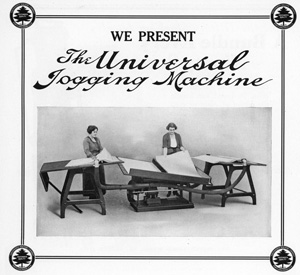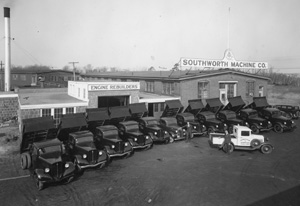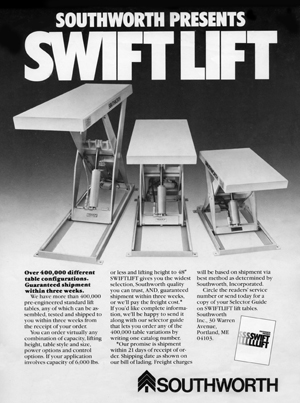Southworth...Since 1890 An Abridged History

The origins of the modern Southworth International Group can be traced to the 1870s in the seaside city of Portland, Maine. The Reverend Francis B. Southworth was the pastor of the Seamen’s Bethel Church on Fore Street in Portland, which provided a church and a place of fellowship for merchant seaman. Keen to provide his flock with a productive way of passing the time while at sea and in foreign ports, Southworth developed and began to produce Bethel library cases. Each of the neat, but inexpensive cases contained a Bible and an assortment of other general reading materials.
 Out of these early publishing activities was born the Southworth Press, a printing press based in Portland. The Reverend Southworth’s four sons – Francis, Edward, Alfred and Constant – went to work with their father in his printing press. Brothers Edward and Constant soon spotted an opportunity to manufacture graphic arts machinery to meet the needs of the growing printing industry and launched their own business in 1890. In 1909 the brothers adopted the famous “Southworth Quality” trademark. In 1910, they incorporated their business as the Southworth Machine Company and built a new manufacturing facility, which was to be the first reinforced concrete factory building in Portland.
Out of these early publishing activities was born the Southworth Press, a printing press based in Portland. The Reverend Southworth’s four sons – Francis, Edward, Alfred and Constant – went to work with their father in his printing press. Brothers Edward and Constant soon spotted an opportunity to manufacture graphic arts machinery to meet the needs of the growing printing industry and launched their own business in 1890. In 1909 the brothers adopted the famous “Southworth Quality” trademark. In 1910, they incorporated their business as the Southworth Machine Company and built a new manufacturing facility, which was to be the first reinforced concrete factory building in Portland.
From the outset Southworth has been characterized by a focus on innovation, quality and the provision of intelligent solutions to customer problems. Early focus industries included the printing and paper-making businesses. With the onset of World War I, the Company manufactured turret lathes, shell trimming devices, wire winding equipment and other products intended for the war effort.
 In 1920, the Company relocated to a modern manufacturing facility on Warren Avenue in Portland, which would remain its headquarters for much of the 20th century. In 1921, the Company added an Automotive Division focused on the manufacture of replacement parts, the rebuilding of engines for trucks, fire apparatus and similar heavy vehicles and the installation of dump bodies. Later the business expanded into the distribution and rebuilding of marine and aircraft engines and parts manufacture. The Automotive Division rebuilt truck fleets for a range of clients including Gulf Oil, Maine Central Transportation Company, Socony Mobile Co., the Coast Guard and assorted gas and diesel powered trawlers in the Maine fishing fleet.
In 1920, the Company relocated to a modern manufacturing facility on Warren Avenue in Portland, which would remain its headquarters for much of the 20th century. In 1921, the Company added an Automotive Division focused on the manufacture of replacement parts, the rebuilding of engines for trucks, fire apparatus and similar heavy vehicles and the installation of dump bodies. Later the business expanded into the distribution and rebuilding of marine and aircraft engines and parts manufacture. The Automotive Division rebuilt truck fleets for a range of clients including Gulf Oil, Maine Central Transportation Company, Socony Mobile Co., the Coast Guard and assorted gas and diesel powered trawlers in the Maine fishing fleet.
Throughout the 1920s and 1930s the Company built fire trucks for towns throughout New England. There are rumored to be two existing Southworth-built fire engines in Kennebunk and Harrison, Maine. In the mid-1930s the Company introduced the Southworth Portable Fire Pump, which could be carried by two men and which was targeted at rural fire departments serving potential fire sites away from good road access.
During the 1930s Southworth continued to focus on product innovation, with Edward Southworth and engineer Grenville Whitney obtaining patents for a range of machinery targeted at the printing, paper-making and textile industries. The Company patented its products in Canada as well, entering that market during the second half of the 1930s.
 With the arrival of World War II, the Southworth machine shop was running around the clock, seven days a week to produce aircraft engine and propeller parts, alongside other vital war material. The plant was expanded, new machinery was purchased and production lines were revamped. The Company began contract machining operations for high precision-close tolerance work for such aerospace customers as Curtiss-Wright, General Electric, Pratt-Whitney and Raytheon. These relationships would continue into the early 1970s.
With the arrival of World War II, the Southworth machine shop was running around the clock, seven days a week to produce aircraft engine and propeller parts, alongside other vital war material. The plant was expanded, new machinery was purchased and production lines were revamped. The Company began contract machining operations for high precision-close tolerance work for such aerospace customers as Curtiss-Wright, General Electric, Pratt-Whitney and Raytheon. These relationships would continue into the early 1970s.
As World War II drew to a close, the Company refocused its efforts on the Graphic Arts, Engine Rebuilding, the aerospace industry and the manufacture of equipment for paper and textile manufacturers. During the 1940s and 1950s Southworth Machine Company was the Caterpillar distributor for northern New England. In 1954 the Company launched a major campaign to build up its manufacturing facilities and product lines. There was a particular focus on the paper industry, which was a prominent component of Maine’s economy. Research on the part of Southworth engineers and production personnel into the problems inherent in handling paper led to the formation of Southworth’s Materials Handling and Papermill division. The division introduced flat sheet handling machinery for use in the paper industry. In 1957 the Company introduced its first line of lift tables with a cam style design. In 1960 the Company introduced a line of coil and roll handling machinery and in 1968 a line of dock and facility lifts. Throughout this period Southworth Machine Company designed and built machinery to the exacting standards of a wide range of leading American and international manufacturers.
During the 1950s and 1960s, the Company established a series of international agreements with partners in Canada, Italy, Japan, the United Kingdom, West Germany, and elsewhere. In the late 1960s the Company entered the Mexican marketplace. These relationships were followed by the establishment of long-running partnerships with Australian and Japanese firms in the 1980s and the creation of a joint venture in China in 1989.
 The late 1970s were a period of considerable transformation. Southworth Machine Company was renamed Southworth, Incorporated, which later became Southworth International Group, Inc. The Company introduced a line of lighter weight, mobile ergonomic products, which form the nucleus of a line of products that the Company continues to produce and sell today. This product line extension proved to be farsighted, as many of the ergonomic concepts that Southworth introduced at that time were well-matched for the 1980s focus on lean manufacturing. In a bit of lean optimization of its own, the Company concurrently pioneered the SWIFT LIFT program to dramatically simplify the process of specifying, ordering and receiving a lift table with minimum lead times. In 1979, the Company opened a new plant in Manila, Arkansas, to better serve its expanding customer base in the Midwest and Southeast.
The late 1970s were a period of considerable transformation. Southworth Machine Company was renamed Southworth, Incorporated, which later became Southworth International Group, Inc. The Company introduced a line of lighter weight, mobile ergonomic products, which form the nucleus of a line of products that the Company continues to produce and sell today. This product line extension proved to be farsighted, as many of the ergonomic concepts that Southworth introduced at that time were well-matched for the 1980s focus on lean manufacturing. In a bit of lean optimization of its own, the Company concurrently pioneered the SWIFT LIFT program to dramatically simplify the process of specifying, ordering and receiving a lift table with minimum lead times. In 1979, the Company opened a new plant in Manila, Arkansas, to better serve its expanding customer base in the Midwest and Southeast.
Following further strategic planning during the 1980s and 1990s, Southworth today is focused on meeting the needs of a demanding customer base across the entire spectrum of manufacturing, distribution and retail industries by providing an innovative and high quality range of lifting, tilting and positioning solutions. The Company has evolved dramatically since the days of the Reverend Southworth and his Bethel libraries. However, the same focus on innovation, quality and intelligent service to customers that have formed the basis of Southworth’s success through the first 125 years of its history continue to drive the Company today.